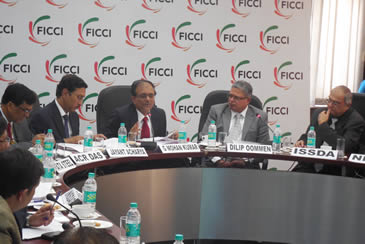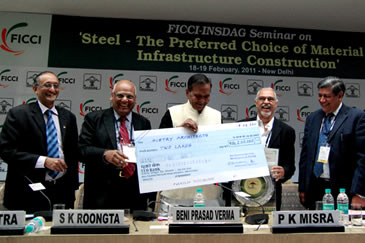Steel is one of the core industries contributing to the development of an economy. India has become the third largest steel producer after China and Japan and is expected to be the second largest producer soon. FICCI’s Steel Committee comprises of CEOs and representatives of leading steel organizations in the country. The committee interacts closely with the Government on various policy issues.
Steel is one of the core industries contributing to the development of an economy. India has become the third largest steel producer after China and Japan and is expected to be the second largest producer soon. FICCI’s Steel Committee comprises of CEOs and representatives of leading steel organizations in the country. The committee interacts closely with the Government on various policy issues. Committee’s objective is to help the country have an efficient world class steel industry catering to diversified requirements of the consuming sectors. FICCI Steel Committee also focuses on how to achieve global benchmarks of productivity, efficiency and adopt best practices in steel production.
Team Leader
Arpan Gupta
Addl. DirectorTimeline
India Steel 2023
Webinar on Decarbonization Challenges and Solutions for Indian Steel Industry
Reducing weight of steel by using Vanadium can help decarbonize steel industry: Additional Industrial Advisor, Ministry of Steel
Webinar on Metallurgy & Applications of Vanadium Containing Steels
Time for India to transit from R&D stage to production of vanadium for usage in steel industry: NITI Aayog
Webinar on Vanadium Usage in Steel Sector
Union Steel Minister Calls for Enhancing Production of Quality Steel; Also Calls for Reduced Dependence on Imports; Sh. RCP Singh Stresses on Importance of Reducing Carbon Footprint while Enhancing Production
Renewable energy, solar power and zero-liquid discharge, zero-waste solutions to become the norm in future for mining and metals industry: Faggan Singh Kulaste, Minister of State in Steel & Rural Development
Future of Indian Mining, Metals & Cement Industries
FICCI welcomes PLI Scheme for Specialty Steel Sector
Need to harness digital revolution in Indian steel sector: Dr VK Saraswat, Member, NITI Aayog
Steel Technology & Innovations: Increasing Productivity & Technology Quotient
National Training-cum-Workshop on Policies for Indian Mining & Metals Industry
One Day National Workshop on Metallurgy For Non-Metallurgist (MFNM-2021)
NITI Aayog and Ministry of Steel making efforts to make steel slag production and utilization a part of the circular economy
Webinar on By-Product Management for Indian Steel Industry: Ecosystem, Opportunities & Challenges
Secondary steel sector to play key role in achieving targets of National Steel Policy 2017 & Atmanirbhar Bharat: Faggan Singh Kulaste
Webinar on Secondary Iron & Steel Industry: Ecosystem, Opportunities & Challenges
Webinar on Manufacturing Value Added Steel: Contribution towards Vocal for Local & Atmanirbhar Bharaton
Government taking steps to reduce logistics cost and support the industry: MoS Steel
Supportive Logistics for Indian Iron & Steel Industry: Ek Kadam Atmanirbharta Ki Aur
Webinar on Atmanirbhar Bharat: Fostering Domestic Steel Usage in Oil & Gas Sector

Webinar on Impact of nCovid19 on Worldwide Steel Industry: Challenges & Opportunities for India
User-Producer Interaction on Promoting Awareness & Usage of Steel Slag
FICCI statement on Supreme Court's judgement on Essar Steel
Dharmendra Pradhan inaugurates Steel 'Chintan Shivir'
Towards a Vibrant, Efficient and Globally Competitive Indian Steel Sector
Industry should learn using LD slag from other countries: Ms Ruchika Chaudhry Govil, Joint Secretary, Ministry of Steel
India to leave behind US in terms of steel consumption this year: Chaudhary Birender Singh
India Steel 2019
Promoting Awareness & Usage of Steel Slag
Steel plants with scrap as raw material to come up in north and western India, says Steel Minister, Ch. Birendra Singh at 2017 World Recycling Convention
India is the focus for optimism in global steel industry, feel steel industry honchos
India Steel 2017
India aiming to be world's second largest steel producer
India Steel 2015

Interactive Session of FICCI Steel & Non-Ferrous Metals committee with Secretary, Ministry of Steel, Government of India
FICCI-INSDAG seminar on "Steel-The Preferred Choice of Material for Construction"

FICCI-INSDAG Seminar on 'Steel – The Preferred Choice of Material for Infrastructure Construction'

National Conference on "Improving Energy Efficiency in Indian Secondary Steel Sector Including Steel Re-Rolling Mills"

Luncheon Address by Shri P K Misra, Secretary, Ministry of Steel on Indian Steel Industry in the Nex Decade
FICCI Seeks Export Measures for Steel to Bridge the Rising Trade Deficit
Steel Ministry to prepare white paper on logistics need for production capacity of 300 million tonnes


















